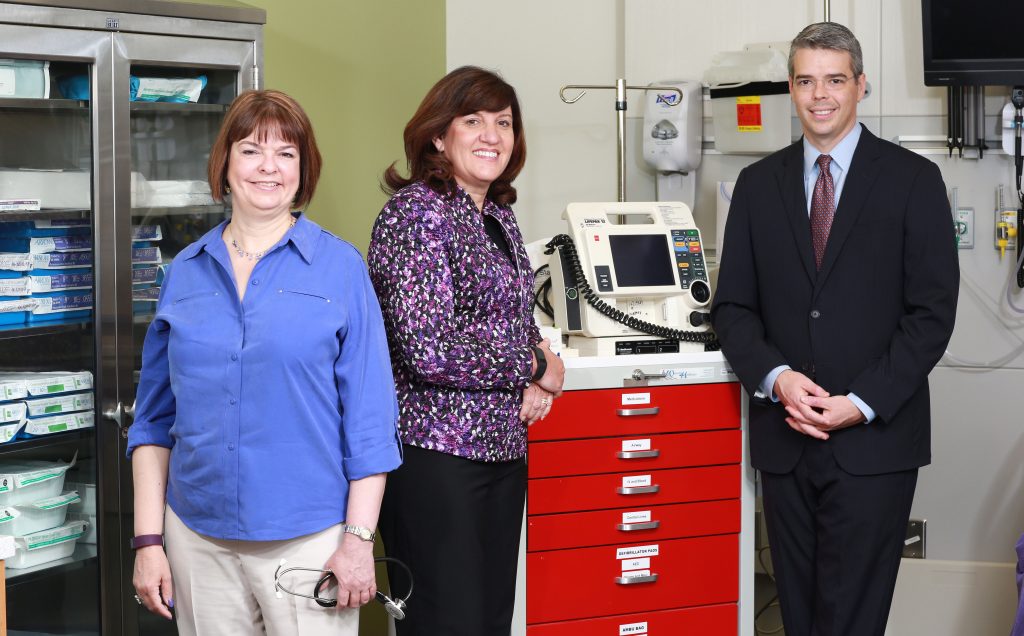
Leading a Culture Change in Health Care
Faculty at the Harris College of Nursing & Health Sciences are helping fuse research with health care practice.
Imagine a relative is having an afternoon surgery, perhaps to repair a broken bone. Chances are, the preoperative instructions forbade food and fluids after midnight. This means the already nervous patient is also hungry and thirsty.
Despite the surgeon’s good intentions, the relative puts his health at risk by complying. Two decades of research recommends abstaining from food for four to six hours before surgery, and from water for only one or two hours. Dehydration during an operation is a real, and unpleasant, possibility.
Preoperative guidelines are among hundreds of outdated yet routine health care standards. Policies ranging from limited visiting hours in intensive care units to choosing intravenous size often are based on habit, not proven best practices.
“Old habits die hard,” said Susan Mace Weeks ’09 DNP, dean of Harris College of Nursing & Health Sciences. “When you or I or any of our family members go to seek health care, 50 percent of the time there’s a better option out there than what they are offered.”
The lag between research-based health care findings and their full implementation averages about 17 years. The delay is expensive, frustrating and potentially fatal.
“Anywhere from 100,000 to over 400,000 lives are lost in the U.S. alone on a yearly basis from lack of best care,” Weeks said. “That’s scary.”
Weeks and her colleagues understood the potential alchemy between nursing schools and practice professionals. “But there wasn’t always a natural point of connection,” she said.
“When you or I or any of our family members go to seek health care, 50 percent of the time there’s a better option out there than what they are offered.”
Susan Mace Weeks '09 DNP, dean of the Harris College of Nursing & Health Sciences
Professors initially planned to launch a faculty consultation program to help advance nursing research at Dallas-Fort Worth hospitals. In 2006, TCU awarded Weeks and two Harris College colleagues a grant to establish the former Center for Evidence Based Practice and Research, which recently split into two entities: The Center for Translational Research and the Center for Collaborative Practice.
“We have all this expertise in answering questions,” said J. Dru Riddle ’11 DNP, assistant professor of professional practice at the Harris School of Nurse Anesthesia and director of the Center for Translational Research. Working professionals “have all this expertise in providing care. And the divide [between research and practice] is bridged with our center.”
Weeks estimates that this year more than 600 Fort Worth-area professionals participated in the Center for Collaborative Practice program. The culture-shifting, multipronged movement seeks to bring diverse health care practitioners together under the banner of research, evidence and measurement. The common goal is a dramatic improvement of patient outcomes.
The Center for Translational Research trains people in the research synthesis process of systematic review. In 2009, Harris College joined with the Joanna Briggs Institute at the University of Adelaide, a champion of evidence-based practice. By disseminating the Australian institute’s model, TCU’s center has become the largest systematic research review trainer in the world. Scholars and health care professionals from far afield come to Fort Worth to learn how to harness the potential knowledge waiting inside millions of volumes of published research.
Nurses at the forefront of health care
Nurses are positioned to influence the delivery of health care, considering there are more than 3 million of them in the United States.
“Nurses are the largest group of health care providers in the country,” said Kathy Baker, associate professor of nursing and director of graduate studies at Harris College. “We’re the ones who are with [patients] around the clock.”
Though nurses might know intuitively what is right for patients, they need scientific proof to convince policymakers, Baker said. “People are much more likely to embrace and utilize their [nurses’] suggestions in practice if they see there’s credible evidence.”

Evidence based practice is a matter of looking to established research to find answers to improve health care practice.
Harnessing health care information can be difficult, but lack of experience, not initiative, is to blame. Baker, a member of the Society of Gastroenterology Nurses and Associates, edits the group’s research journal. She fostered a partnership between the society and TCU to help shift the research culture in her specialty. The collaboration has improved the way endoscopes are stored, as contamination can be an issue.
While transforming practice on a global scale is ideal, the newly renamed Center for Collaborative Practice’s primary emphasis is improving patient care in North Texas. In 2007, it launched a yearlong fellowship program for Dallas-Fort Worth nurses.
The fellowship training includes how to identify practice problems and where to look for solutions. “Evidence-based practice is where you have a question, and it’s already answered,” said Colyn Barry, a Dallas-based nurse and recent fellowship graduate. “You just have to go find the answer.”
Barry was among dozens of nurses who described the results of their information quests at the fellowship’s graduation ceremony in September 2015. In examining everything from a designated quiet time in neonatal intensive care units to bedside chemotherapy education for cancer patients, the nursing fellows discussed the ease of influencing hospital policies by locating appropriate research.
“It was very empowering to see, wow, all I had to do was ask and show the evidence, and we changed our practice.”
Erica Watkins, a 2012 graduate of the Center for Collaborative Practice's evidence-based practice fellowship
After explaining her recommendations for shorter emergency room stays, Barry said that before the fellowship, she wasn’t comfortable with the idea of mixing research and a busy work shift. Evidence-based practice isn’t so daunting, she said. “It’s like being a translator of research.”
Erica Watkins, a 2012 fellowship graduate, conducted an informal survey at a hospital’s emergency department for her project. Watkins asked her colleagues: “What bothers you? What is there that we do that you just can’t stand or don’t understand why we do it that way?” The most-repeated answer, said Watkins, pointed to making people suspected of having appendicitis drink contrast dye and wait, even if the extended emergency room visit and mouthfuls of thick goop exacerbated a painful situation.
Using the fellowship’s instructions on finding and appraising appropriate research literature, Watkins searched for the scientific consensus. She found ample evidence to support her theory that the dye requirement was unnecessary and that a prompt CT scan resulted in an equally effective diagnosis – while skimming two hours from the emergency room stay of each suspected appendicitis sufferer.
Watkins compiled the evidence along with a formal proposal and presented her dye-free plan to the hospital’s radiologists. She said the doctors immediately agreed to implement her suggestion.
Before and after the hospital eliminated its dye requirement, Watkins collected data on length of stay for patients with appendicitis. Her research-based recommendation saved time and money, and other hospitals took notice.
Watkins’ plan is now standard in all of her employer’s North Texas emergency rooms.
“It was very empowering to see, wow, all I had to do was ask and show the evidence, and we changed our practice,” she said.
Leaders in systematic review
Riddle, a nurse anesthetist, earned a doctorate in nursing practice at TCU and conducted a systematic review for his final project. Would monitoring brain activity during surgery to provide the minimum amount of necessary anesthesia reduce a patient’s time in post-operative care?
By assembling and then aggregating suitable studies, Riddle found that the tailored anesthesia procedure would cut each patient’s time in the recovery room by four-and-a-half minutes – a small amount until he multiplied the minutes by each surgery in the hospital. By implementing his recommendation, one hospital could save more than $1 million per year.
As director of translational research, Riddle leads the systematic review training efforts. He explains the step-by-step method of finding all relevant research, then paring it down to the studies with sufficient details to justify their methodology. The next step involves combining results from the suitable reports and averaging across variables to find fresh conclusions.
For studies with quantitative data, this process is called meta-analysis. But a lot of questions can’t be answered with a traditional trial, Riddle said. For example, concerning inquiries into patient satisfaction or quality of life issues, a meta-aggregation of qualitative reports is the norm.
Using the Joanna Briggs Institute’s straightforward model, “systematic review has [empowered] people that never thought they could conduct research because it was either too scary or too laborious or too entrenched in academe,” he said.
“We’re not just answering questions for the sake of doing research. We’re answering questions for the sake of improving lives, impacting health.”
J. Dru Riddle ’11 DNP, assistant professor of professional practice at the Harris School of Nurse Anesthesia and director of the Center for Translational Research
Brian Benham ’14 DNP, an associate professor of nurse anesthesia for the U.S. Army’s graduate program, met Riddle through TCU’s doctoral program. Systematic review training was required for Benham’s degree and was a skill his employer needed. The director of the Army’s nurse anesthesia program wanted Benham to determine how to stem its attrition rate. The program graduates were badly needed by the Army.
With Riddle’s training, Benham learned to cull through hundreds and hundreds of articles, theses and dissertations to find the gems that addressed his questions. Through aggregation, Benham found that undergraduate grade-point averages best predicted successful completion of a graduate health care program.
The Army’s nurse anesthesia program implemented Benham’s findings by prioritizing applicants who made good grades as undergraduates. Although the change is too recent to measure, Benham said because of the caliber and attitude of the current students, he expects the admission change to deliver the desired results.
Benham wants to launch more systematic review queries because the evidence is everywhere but in practice. “There is no more important thing that we could do as health care providers than to be sure that what we’re doing is the best for our patients,” he said.
Riddle plans to create an interdisciplinary, interprofessional movement around systematic review. “I think there’s a lot of potential to collaborate with an almost endless number” of people and academic fields, he said. “It goes far beyond what you think of hard science.
“We’re not just answering questions for the sake of doing research,” Riddle said. “We’re answering questions for the sake of improving lives, impacting health.”
Expanding the effect
In July, the two centers became part of the Health Innovation Institute at TCU, a collaboration of Translational Research; Collaborative Practice; the Center for Oncology Education and Research; and the Let’s Inspire Innovation ‘N Kids Center.
As health care enters the age of informatics, and insurance companies use data to approve and reject treatments, providing optimal care is not just a good idea but an imperative, said Diane Hawley, associate professor of professional practice at Harris College.

Kathy Baker, Diane Hawley and Dru Riddle are professors at Harris College of Nursing & Health Sciences and advocates for applying research to the practice of health care. (photo by Carolyn Cruz)
“The culture is changing. There’s a huge movement afoot to be patient-centered,” said Hawley, who focuses on measuring the overall effect of the fellowship program.
Helping nurses deliver up-to-date care is part of her role as a faculty consultant to Fort Worth-area hospitals. Hawley advocates for a spirit of inquiry. “We’re getting the nurses to question why.”
Nurses appreciate the collaboration the center drives in a competitive health care market.
“It’s terrific,” said Mary Robinson, chief nursing officer at a hospital in Fort Worth. “Having TCU own this and lead the initiative has created an opportunity for hospitals from all over the (Dallas-Fort Worth) metroplex to come together and benefit.”
For Watkins, the fellowship experience of creating change shaped her career.
“My biggest takeaway from the program was to realize there’s so much more to my practice than just what I do at the bedside … to question why do we do this this way? Is there a better way?” she said.
Watkins now serves as education coordinator for her hospital’s emergency department. She turns colleagues onto the power of mixing research with making rounds. She leads several evidence-based information quests, including a search for methods to reduce blood culture contamination.
For Juanita Hernandez’s fellowship project, she helped eliminate redundant methods of stimulating blood flow to prevent clots. But the benefits of incorporating research findings into her work were just beginning.
“I know that I have the power to make a difference,” she said. “I know how to examine the evidence and look for those best practices.”
After the fellowship and subsequent graduate school, Hernandez is now manager of a medical surgical telemetry unit at a Fort Worth hospital. She compared her research-based mindset to being a detective. From ulcer reduction to how best to use surgical drains, Hernandez turns to academic journals for information.
Hernandez’s most important role, so far, might be in fall prevention. She teaches nurses to make rounds with purpose – so patients won’t have a reason to leave their beds – and creates policies for factors such as bed rail height. As a result, Hernandez has reduced her floor’s fall rate by almost half in one year.
Unsatisfied with the few remaining falls, Hernandez returned to a spirit of inquiry and asked: “What else?” She noticed that the persistent falls occurred with people older than 65 whose families said had been acting strange. Turning to the research literature, Hernandez discovered that administering anti-anxiety medications, such as Ativan, to that age group often induced delirium.
“Sure enough,” she said, the medicine was a factor. Hernandez is working to find better alternatives and will not stop until no patients on her unit fall.
If a practice can be better, Hernandez wants to ensure it is. “We want to take care of these patients like we want our own family members taken care of,” she said. “And you know, when you provide that type of care, you actually enjoy your nursing more.”

Your comments are welcome
3 Comments
Wow! Such an informative article!
Health care communities are making person-centered dining programs the center of attraction! Nursing homes and assisted living facilities alike are embracing the concept of changing their internal culture from institutional-based care to person-centered care where the individual is at the center.
Awesome! Cheers to improving lives and impacting health! Hope this will lead to a more positive, patient-centered culture change in health care.
primary care physician San Antonio
Related reading:
Features
Politics 101
Students appraise the political landscape
Campus News: Alma Matters
Beyond the Spectrum
Naomi Ekas is using positive psychology to ease the stress experienced by parents of children with autism.